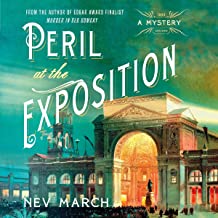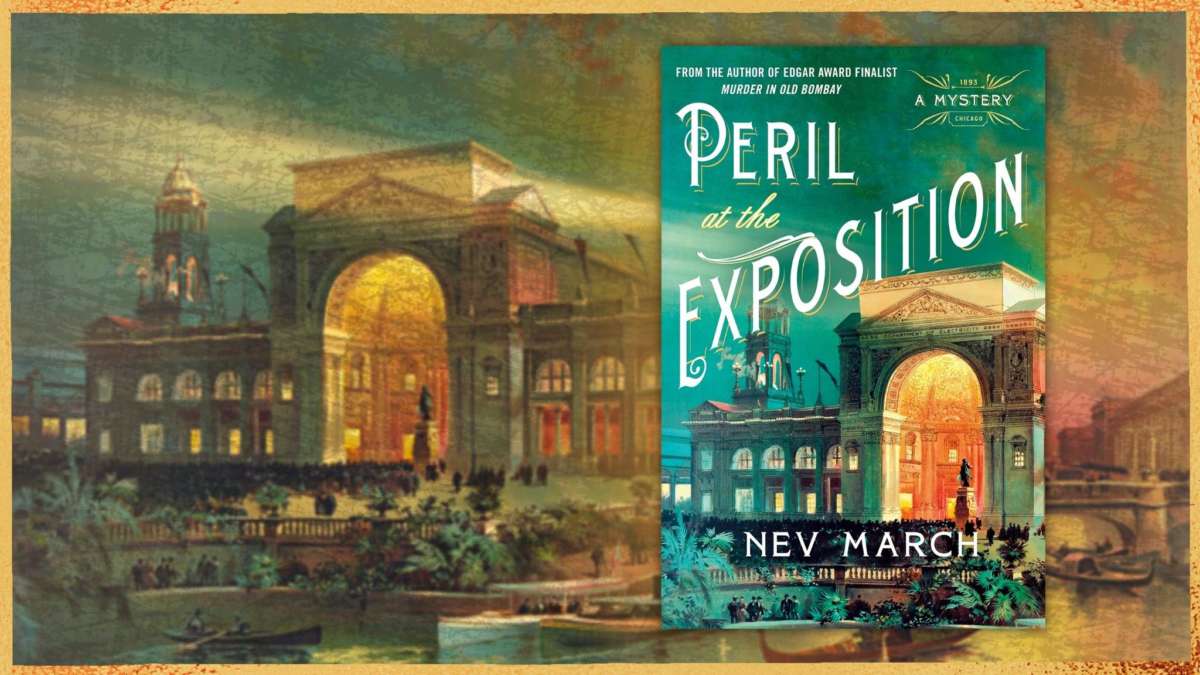Peril at the Exposition by Nev March
In her exciting sequel to Murder in Old Bombay, Nev March turns back time to transport the reader to the 1893 Chicago World’s Fair in Peril at the Exposition (Minotaur).
The protagonists of Bombay return, as Captain James Agnihotri and his new bride, Diana, have immigrated to the United States from India as James begins a career as a private detective in Boston. He’s dispatched to Chicago to investigate the murder of a client, a young business executive, and one of his colleagues, because the lack of clues has stymied the police and the Pinkerton Agency.
James leaves Diana safely behind in Boston, but after weeks of torturous silence from her husband, Diana grows concerned. A mysterious German professor, who lands on her doorstep bearing a puzzling letter that James has sent him for translation, stokes her worries. The professor declines to translate the letter, but Diana does, is struck by the mention of importing explosives into Chicago, and recognizes that trouble is brewing. She must warn James about this latest development, so Diana convinces his employers to engage her to find and warn him about the impending danger.
Until Diana and James reconnect in Chicago, Diana takes the lead in the uncovering the location and reason for the explosives. Along the way, she accumulates an intriguing posse of a free Black man, a cross-dressing actor and a street urchin. The societal restrictions of womanhood in the 19th Century prohibit her access to certain places and persons, so her rag-tag team becomes her eyes and ears at the docks, meeting halls and factories of a city preparing for worldwide attention. Fortunately, her well-connected friends from India and Boston introduce her to Chicago’s upper-crust society, and doors open wide when the hoity-toity mistakenly believe she is an Indian Princess, known as Lady Diana.
Meanwhile, James has gone undercover to investigate the murders, living among the dock and factory workers. To find the killers, he insinuates himself in a dark and dangerous world of labor unions, anarchists and criminals to solve the crimes. When Diana finally locates him, she reveals the plot to import eight hundred pounds of balliste, a highly volatile explosive, to Chicago. They must discover who placed the order, the reason for the order, and the intended target.
Both Diana and James wonder whether there is a connection between the murders and the explosive, and embark on parallel efforts to uncover the truth before the explosives destroy their intended target.
AT THE CROSSROADS OF GLAMOUR, SQUALOR AND MURDER
It would not be a spoiler to disclose the focus of the deadly plot. It’s the 1893 Chicago World’s Fair, and March paints an intriguing mystery to unearth who are scheming to blow up the fair and why. Suspects with conflicting motives abound. As the post-Civil War Industrial Revolution explodes in America, its citizen face challenges never experienced, such as overcrowded cities, poor air-quality, low wages, the rise of tenements, labor unrest and the growth of the railroads. In contrast to these issues, the world’s attention is focused upon the fantastic wonderland created in Chicago to celebrate the 400th anniversary of Columbus’ discovery of America. March emphasizes the class and societal struggles instigated by the fair to create a tension tearing at her main characters. They feel sympathy for the downtrodden, but are seduced by the spoils of the rich, which they encounter during their investigations. It’s difficult for Diana and James to disdain champagne and caviar, even though people living in squalor of tenements surround them.
March’s superb descriptions of the magnificent buildings, lakes, promenades and inventions presented at the Exposition, as well as the character’s starched clothing and stiff manners, invite the reader to feel as if they are attending the fair. Weaving the characters’ interactions with the politicians and celebrities of the time, such as Nicholas Tesla and Thomas Edison, into the narrative serves as a clever device to further enhance the historic atmosphere of the mystery.
At its heart, Peril at the Exposition is a historical, cozy mystery perfect for the poolside or beach. The characters are charming, especially Lady Diana, who dearly misses India and often wonders what attracts her husband James to their strange new homeland. Capturing the taste of the sights and smells of India, and the excitement, hustle and bustle of 19th Century Chicago, March has created the perfect armchair escape from the summer blues in Peril at the Exposition.
RELATED POSTS:
Is it Suicide or “Murder in Old Bombay”?
About Nev March:
Nev March is the recent winner of the Minotaur Books/Mystery Writers of America Award for Best First Crime Fiction. After a long career in business analysis, in 2015 she returned to her passion, writing fiction and now teaches creative writing at Rutgers-Osher Institute. A Parsee Zoroastrian herself, she lives in New Jersey with her husband and two sons.





